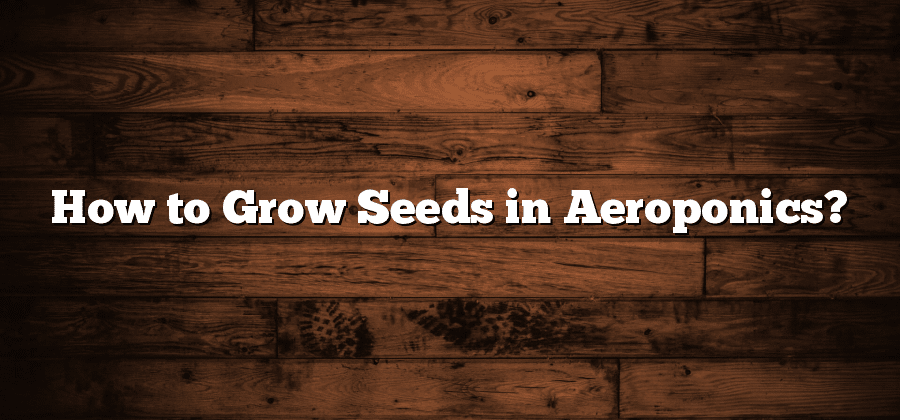Benefits of Growing Seeds in Aeroponics
Aeroponics is a modern method of growing plants that offers numerous benefits when it comes to seed cultivation. One of the key advantages of growing seeds in aeroponics is the significant increase in the success rate of germination. By providing the seeds with a controlled mist of nutrients and water, aeroponics ensures that the seeds receive optimal conditions for growth. This method eliminates the risk of overwatering or underwatering, which can often hinder seed germination in traditional soil-based methods.
Furthermore, aeroponics also promotes faster and healthier seedlings. Because the seeds are exposed to a nutrient-rich mist, they can quickly absorb the essential elements needed for growth. This results in accelerated root development and overall plant growth, leading to stronger and sturdier seedlings. With aeroponics, plants can mature at a faster pace, enabling a higher yield in a shorter period of time. Additionally, the absence of soil in aeroponic systems reduces the risk of pests and diseases, further contributing to healthier plants.
Selection of Seeds for Aeroponics
When it comes to selecting seeds for aeroponics, there are several factors to consider. First and foremost, it is important to choose seeds that are suitable for the specific crop you intend to grow. Different plants have different requirements, including temperature, humidity, and nutrient levels. Therefore, it is crucial to do thorough research on the optimal conditions for each crop and choose seeds accordingly.
In addition to considering the specific crop, it is also important to select high-quality seeds. Look for reputable seed suppliers who provide seeds that have been tested for germination rates and genetic purity. This will ensure that you are starting with the best possible foundation for your aeroponic garden. Additionally, consider choosing seeds that are suited for hydroponic or soilless cultivation methods, as these will likely adapt well to aeroponics. By carefully selecting seeds that are well-suited for your desired crop and ensuring their quality, you are setting yourself up for success in your aeroponic gardening endeavors.
Preparation of Seedlings for Aeroponics
To ensure successful growth in an aeroponic system, proper preparation of seedlings is crucial. The first step in this process is selecting high-quality seeds that are well-suited for aeroponic cultivation. It is important to choose seeds that are disease-free and have good germination rates. Additionally, opt for varieties that are known to thrive in aeroponic environments, as they have been specifically bred to withstand the unique conditions of this growing method.
Once the seeds have been selected, it is time for germination. This can be done using various methods, but one popular approach is using seedling trays filled with a sterile growing medium. Place the seeds in the tray, making sure to provide enough space between them for proper growth. It is important to keep the growing medium consistently moist, but not overly saturated, to prevent rot or mold. Regular monitoring and adjustment of moisture levels will promote strong germination and healthy seedling development.
With a focus on seed selection and proper germination, the preparation of seedlings for aeroponics sets the foundation for successful growth. By ensuring the right seeds are chosen and germinated effectively, growers can maximize the potential of their aeroponic system.
Creating the Perfect Aeroponic Environment
While aeroponics offers many advantages for growing plants, creating the perfect environment is crucial for their success. One of the key factors to consider is temperature. Aeroponic systems thrive in environments where the temperature stays consistently between 18 and 27 degrees Celsius. This optimal range ensures that the plants receive enough warmth for growth without being subjected to excessive heat that may hinder their development.
Another important aspect is humidity. Maintaining the right level of humidity is essential for the root systems to absorb water and nutrients efficiently. Ideally, the humidity should be around 80-90% during the initial stages of growth. As the plants mature, it can be gradually reduced to 60-70%. This balance prevents the roots from becoming waterlogged and reduces the risk of pathogens, while still providing sufficient moisture for the plants to thrive. Ensuring a well-ventilated environment further aids in maintaining appropriate levels of humidity and prevents the buildup of stale air.
Transplanting Seedlings into the Aeroponic System
A crucial step in the process of aeroponic gardening is transplanting seedlings into the aeroponic system. This step requires careful handling and attention to ensure the successful growth and development of the plants. Before transplanting, it is essential to ensure that the seedlings are healthy and strong. Any weak or damaged seedlings should be discarded to prevent the spread of diseases or pests within the system. Once the seedlings have been selected, they need to be gently removed from their original containers, taking great care not to damage the delicate roots. This is best done by holding the seedling at the base of the stem and gently easing it out of the container, taking care to keep the roots intact.
After the seedlings have been carefully removed, they should be placed into the aeroponic system. The system should have already been prepared and set up with the necessary water and nutrient solution. When placing the seedlings, it is important to ensure that the roots are fully submerged in the solution while the stem and leaves remain above the surface. This allows the roots to absorb the necessary nutrients while also providing the plant with the necessary oxygen for healthy growth. Care should be taken not to overcrowd the system, as this can lead to competition for nutrients and limited space, which may hinder growth. Once the seedlings are in place, it is crucial to monitor their progress closely to ensure they adapt well to the aeroponic environment and thrive.






